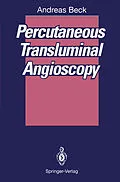Percutaneous transluminal angioscopy is opening up exciting possibilities for the interventional radiologist, since it can picture vascular features with an accuracy and clarity that previously has not been possible. Dr. Beck paves the way for the use of this new tool in clinical diagnosis; he details the technical prerequisites, gives step-by-step instructions for applying the technique and discusses how to interprete the resulting images. The amazing results of percutaneous angioscopy are compared with the results of conventional angioscopy. This approach introduces the new and unknown in perspective with the tried and trusted of the past. Major advantages become obvious: unclear or uncertain angiographical findings can be cleared up, interventional procedures can be supported, and the effects of interventional radiology can be seen before and after vascular treatment. The author's unique insight and systematic approach to the vascular system make this atlas a truly pioneering work.
Inhalt
1 Introduction.- 2 A Historical View.- 2.1 History of Angiography.- 2.2 The Development of Therapeutic Angiography.- 2.3 Modern Interventional Techniques.- 3 Percutaneous Transluminal Angioscopy.- 3.1 Material and Methods.- 3.1.1 Angioscopic Equipment.- 3.1.2 Access for Vascular Endoscopy.- 3.1.3 Intravascular Positioning of the Angioscope.- 3.1.4 Clearing the Blood from the Vascular Lumen.- 3.1.5 Forced Sodium Chloride Perfusion.- 3.1.6 Recording Techniques.- 3.2 Animal Studies as a Precondition for Angioscopy in Man.- 3.3 Indication for Angioscopy.- 4 Angioscopic Diagnosis of Vascular Changes.- 4.1 Normal Vessels.- 4.2 Pathological Vascular Features.- 4.2.1 Atherosclerosis.- 4.2.2 Thrombosis.- 4.2.3 Vascular Inflammation.- 4.2.4 Actinic Vascular Injuries.- 5 Interventional Procedures in Angioscopy.- 5.1 The Method of PTA Control.- 5.2 Angioscopic Results After PTA.- 5.3 Method for Lysis Control.- 5.4 Angioscopic Results of Local Lysis.- 5.5 Method of Stent Implantation.- 5.6 Angioscopic Results of Stent Implantation.- 5.6.1 Angioscopic Stent Implantation and Control in Animal Experiments.- 5.6.2 Angioscopic Stent Implantation and Control in Patients.- 5.7 The Invention of a Method of Percutaneous Transluminal Thrombus Extraction and Its Angioscopic Control.- 5.7.1 Principle, Material, and Method.- 5.7.2 Angioscopic and Angiographic Results in Animal Studies and Clinical Experience in Patients.- 5.8 Other Possibilities for the Use of Vascular Intraluminal Angioscopy.- 6 Conclusions.- 7 Future Aspects of Percutaneous Angioscopy.- References.
